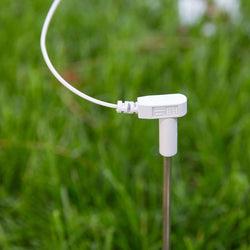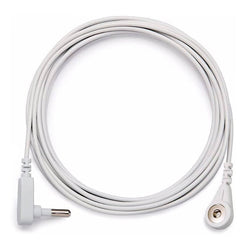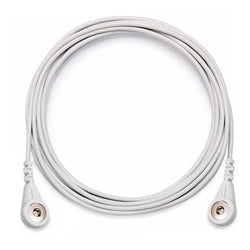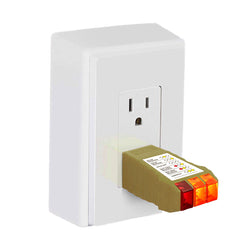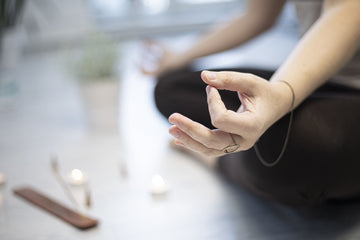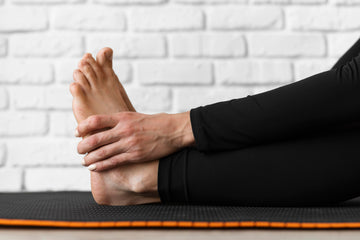Grounding Meets the Spirit
In today’s noisy world, where social media scrolls never end and our minds are constantly pulled in different directions, it’s easy to feel disconnected—not just from others, but from ourselves. Many people have heard of “grounding” as a way to calm anxiety or improve health. But what if we told you grounding isn’t just a physical tool—it’s also a powerful spiritual practice?
Spiritual grounding means being fully present in the body, connected to the earth beneath your feet, and rooted in your soul’s truth. While physical grounding supports the body by balancing energy and reducing stress, spiritual grounding goes deeper. It helps us feel centered, focused, and safe in the present moment—even when life feels chaotic.
When you begin a grounding practice, you don’t just relax your body—you invite your spirit back home. You become more aware of your existence, breath, your senses, and your connection to something bigger than yourself. Through various techniques you start to feel grounded, calm, and whole.
In this guide, we’ll explore grounding as a spiritual practice: how it helps you awaken, how it supports your energy levels, and how it keeps you centered in everyday life. You’ll learn how to walk barefoot, use grounding products and affirmations, and harness the healing energy of the Earth to stay grounded on your journey.
👉 Explore more: Grounding: The Science-Backed Practice to Reconnect, Heal, and Thrive
The Deeper Meaning of Spiritual Grounding
At its core, spiritual grounding is the process of anchoring your spirit into your physical body and the Earth’s energy field. It's about feeling connected to the here and now, as in meditation—not lost in thoughts of the past or worries about the future.
When a person is spiritually ungrounded, he or she may experience symptoms like anxiety, emotional overwhelm, or even a sense of floating outside the body. You might find yourself daydreaming constantly, feeling fatigue that doesn’t go away, or feeling you repeatedly make "wrong" decisions. These are signs that your energy isn’t rooted.
Ancient traditions understood the importance of staying grounded. In many Indigenous cultures, the Earth is considered a living being—Mother Earth—who offers wisdom and support to every person. Eastern systems like Ayurveda and Traditional Chinese Medicine also emphasize grounding through connection to nature, breath, and movement. Gaia theory, a more modern interpretation, views Earth as a self-regulating organism that we are deeply a part of.

Spiritual grounding reminds us that we’re not separate from the Earth—we are Earth. Our body is made of her elements. Our senses respond to her cycles. And when we connect back to her energy, we return to a state of balance and well being.
Spiritual Awakening and the Importance of Staying Grounded
A spiritual awakening does not refer only to feeling closer to some god, it happens when your awareness expands and you begin to see life with new clarity. You may start to question old beliefs, experience emotional releases, or feel a strong pull toward something more meaningful. While this process is powerful, it can also feel destabilizing.
Why? Because as our energy shifts and rises, we often feel ungrounded. Our sleep changes, our emotions intensify, and our sense of reality can blur. That’s why it's essential to stay grounded during spiritual growth.
Grounding during a spiritual awakening creates a safe space for transformation. It helps you integrate what you’re experiencing so that you don’t get lost in the highs or crushed by the lows. Think of it this way: the higher a tree grows, the deeper its roots must be. The same applies to your spiritual journey—you need strong roots to rise in consciousness.
When you develop a daily grounding practice, your mind and body feel more supported. You begin to move through life with grace, clarity, and peace. Grounding doesn’t hold you back; it gives you the stability to fly.
👉 Read more about Earthing Detox Symptoms
Why Walking Barefoot Supports Your Spiritual Journey
One of the most ancient and effective ways to ground is by walking barefoot. Known as earthing, this simple act of placing your bare feet on the earth beneath you creates a direct connection to the planet’s energy field.
There’s something sacred about feeling grass between your toes, warm sand on your soles, or cool soil after rain. It reminds you of your humanness and awakens your senses. In many religious and spiritual traditions, going barefoot is often a sign of humility and reverence.

Modern science also supports barefoot walking. It has been shown to help regulate the nervous system, reduce stress, and improve sleep by syncing your body with the Earth’s natural rhythms. Energetically, thus walking does matter as it allows positive emotions to flow, enhances presence, and clears stagnant energy from the body.
When you walk the Earth barefoot, you’re not just moving physically—you’re participating in an ancient practice that helps you feel grounded and fully alive.
👉 Want to ground when barefoot isn’t possible? Find yourself beloved Grounding Footwear from our wide selection.
How Grounding Techniques Anchor the Aura and Subtle Energy Bodies
Every person has an auric field—an energy body that surrounds and protects us. This field can become scattered or weak when we’re overstimulated, in pain, exhausted, or emotionally drained. That’s where grounding techniques come in.
By using grounding to support the root chakra and etheric body, you create a solid energetic base. Think of it as plugging your entire body into a steady current of healing energy from the Earth. This helps regulate emotions, clear negative energy, and realign your soul with your physical world.
You don’t need to be an energy healer to benefit. Basic techniques like meditation, breathwork, grounding mats, grounding sheets, pillowcases, throw blankets or even holding smoky quartz can stabilize your energy. Grounding, like meditation, is the bridge between spiritual insight and physical experience.
Meditative grounding focuses on inner awareness—like imagining roots growing from your feet into the Earth. Physical grounding techniques include using grounding products or walking outdoors. Together, they form a powerful combo that anchors you in the here and now.
Reclaiming the Present Moment Through Grounding
One of the most powerful benefits of grounding is its ability to bring us fully into the present moment. In spiritual terms, this is the space where transformation happens. The past holds memories, and the future holds dreams, but the present is where your soul communicates, where your breath moves, and where your true awareness begins.

Grounding helps quiet the mental noise and emotional clutter. When you place your feet on the ground beneath, take a conscious breath, and engage all your senses, you begin to return to what is real and sacred. The sound of the wind, the scent of rain, the feeling of grass—these are the gateways to now.
When you spend even a few moments each day fully grounded in the present, your spiritual practice deepens. You stop chasing signs and synchronicities and instead begin to receive them naturally, because your energy is aligned with what life is offering in real time.
Using Meditation as a Spiritual Grounding Tool
Meditation is often seen as a tool for expansion, but it’s equally vital for grounding. A focused meditation practice that connects you to the earth can strengthen your energy field, relax your body, and stabilize your thoughts.
Try a simple grounding meditation: sit comfortably, close your eyes, and visualize roots growing from your feet into the earth’s surface. Imagine the energy of the planet rising gently through those roots and filling your entire body with calm and clarity.
This practice, repeated daily, helps reduce anxiety, release fear, and enhance positive emotions. It’s especially powerful during periods of change, grief, or emotional overwhelm. Grounding meditations don’t disconnect you—they bring you into alignment with your true, unshakable center.
Grounding Crystals and Earth-Based Tools for Spiritual Support
Beyond mats and sheets, spiritual traditions often turn to smoky quartz and other grounding stones to support energetic balance. These crystals carry dense vibrations that help anchor your spirit to the physical world, shielding your aura and reinforcing your connection to the Earth.
Keep a piece of quartz in your pocket or by your bed. Hold it during your meditations or use it while repeating grounding affirmations like, “I release what does not serve me and root into the now.”
Other tools like essential oils (think cedarwood or vetiver), salt baths, and clay-based foot masks also offer healing energy drawn from the earth’s elements. These practices aren't just symbolic—they allow your body to reconnect with the ancient wisdom of nature.
Focusing on the Senses to Stay Grounded

A quick way to stay grounded throughout your daily life is to pay attention to your senses. Your senses are always in the present—they cannot function in the past or the future. Tuning into them anchors your awareness.
Notice what you see, hear, smell, and touch. What do your feet feel beneath you? What are your hands holding? Even drinking water or savoring a warm drink can become a grounding ritual when done mindfully.
Using focusing techniques like this gives you access to peace without needing a formal setting. You can ground anywhere—at your desk, in traffic, in conversation—simply by engaging with what’s real, tactile, and sensory in the moment.
The Role of Self-Talk and Grounding Affirmations
When we feel scattered, our self-talk often becomes fear-based. We think, “I can’t do this,” or “Everything is too much.” One powerful way to shift out of this state is through grounding affirmations—simple, truth-based statements that redirect your energy.
Say aloud:
“I am safe.”
“I belong in this world.”
“My feet are on the ground, and I am in my body.”
“I am here, and now is enough.”
Repeating affirmations calms the mind, soothes the nervous system, and retrains your thoughts toward safety and strength. Like roots growing deeper with each repetition, your spirit learns to trust the ground again.
Embodiment: Letting the Body Lead the Spirit
Spirituality sometimes forgets the body, but true awakening happens through it. Your entire body is a channel for energy—from the soles of your feet to the crown of your head. Grounding brings your spirit not “out there,” but into the wisdom of your own form.
Embodiment is the act of being fully present in your physical self. Dance, movement, stretching, and walking barefoot are not just exercises—they are sacred acts of claiming your space in the world.
By allowing the body to lead, you move from disconnection to intimacy with life itself. You begin to feel more—more joy, more presence, more peace—and your spiritual grounding becomes not an idea, but a lived experience.
Embracing Stillness in a World of Constant Motion
We live in a culture that glorifies productivity and speed. But grounding teaches us that there is wisdom in stillness. When you pause, sit with your feet on the earth, and simply breathe, you access a kind of intelligence that doesn’t come from the mind.
This stillness is where guidance is born. It’s where your soul speaks and your fears dissolve. Many spiritual texts, from Buddhism to the teachings of Jesus Christ, emphasize withdrawing from the noise to find deeper clarity.
Grounding is your doorway to that stillness. And in that space, you can stay connected to yourself even when the world feels like it’s spinning fast.
Grounding as the Foundation for Spiritual Resilience
Life brings change, loss, beauty, and uncertainty. What allows us to move through it all with grace is not detachment—it’s grounding. When you have strong roots, you can bend without breaking. You can feel deeply without drowning.
Spiritual resilience isn’t about escaping pain. It’s about facing it with both feet on the ground. It’s knowing that even in your hardest moments, the earth holds you.
Through consistent grounding practices, you build this resilience. You train your energy to return to center again and again. You become unshakable—not because life gets easier, but because you’ve learned how to be present for all of it.
The Grounding Practice for Mind, Body, and Spirit
To build a holistic grounding practice, start with a few simple rituals each day. In the morning, sit quietly with your breath for a few moments. Place your feet on the floor and say a grounding affirmation such as, “I am safe, I am connected to the Earth.”
During the day, pause to check in with your body. Do you feel tense? Use your senses to come back to the present: listen to the sounds around you, smell the air, touch something natural. Notice how your mind and body respond to these small acts of presence.
At night, unwind using a grounding pillowcase or sheet. These tools allow the energy of the earth to support you while you sleep, helping to calm your nervous system and release muscle tension.
Keep a spiritual journal to process your emotions and reflections. Use grounding affirmations or self-talk to reinforce stability: “My body is home. I belong here. I am grounded.”
👉 Try our Grounding Sheets and Grounding Pillowcase
Practical Ways to Feel Grounded in Everyday Life
Life gets busy. We get overwhelmed by screens, endless tasks, and emotional demands. These are moments when it's easy to feel scattered. But there are practical ways to return to the present moment.
Step outside and take a slow walk. Let nature reset your rhythm. Make a cup of herbal tea and drink it with full attention. Turn off digital devices for a while and simply feel your breath.
Spending a few moments with your hands in soil or using a grounding mat indoors can make a world of difference. These tools help bring the earth’s energy into your home, especially when going outside isn’t an option.
When you build these practices into your daily life, you create space for peace and clarity. You become more aware, more centered—and more fully yourself.
👉 Discover our full Grounding Products Collection
Staying Grounded in a Spiritually Distracted World
In the age of “spiritual influencers” and constant content, it’s easy to fall into the trap of spiritual bypassing—using positivity or escapism to avoid hard truths. Ironically, all this chasing of higher states can leave us feeling unbalanced and unwell.
The solution? Come back to earth. Stay rooted in your body. Trust the ground beneath your feet. The goal isn’t to escape life—it’s to live it with presence and awareness.
Earthing helps combat this modern spiritual burnout. When you reconnect with the physical world, you’re better able to discern what’s real, what’s true, and what needs healing.
👉 Related: Grounding and EMF Sensitivity
How Earthing Products Can Support Your Grounding Practice
Grounding tools are modern-day bridges between spiritual practice and everyday convenience. A grounding mat, placed under your desk or bed, helps you feel grounded while you work or sleep. A sheet or pillowcase delivers subtle Earth energy as you rest. Even adhesive patches can deliver healing energy directly to parts of the body.
For beginners, start simple. Choose one product and use it consistently. Over time, you’ll notice shifts in your sleep, focus, and emotional calm. The key is consistency and quality—choose products that connect well and support your full practice.
👉 Start your journey with our Grounding Products Collection
Return to the Earth, Return to Yourself
In a world that often pulls us in every direction, grounding is the sacred act of coming home. It brings your soul, body, and mind into alignment. It helps you feel calm, steady, and present.
By embracing grounding as a spiritual practice, you open the door to deeper awareness, hope, positive emotions, and resilience. You begin to stay connected to your truth—no matter how loud the world becomes.
To rise in spirit, we must root into the Earth. And that begins—quite literally—beneath your feet.
Frequently Asked Questions
1. What is grounding in spirituality?
Spiritual grounding is the practice of connecting your energy and awareness to the Earth and the present moment. It helps you feel safe, calm, and rooted. While physical grounding focuses on body connection, spiritual grounding aligns your energy with the physical world, creating balance and emotional clarity.
2. How long should you ground per day?
Even 10–20 minutes a day can help. The key is consistency. Whether you’re walking barefoot, meditating, or using grounding tools, daily practice supports emotional stability and positive emotions. Longer sessions are helpful during stress or spiritual growth.
3. How to practice being grounded?
You can stay grounded by using your senses, breathing deeply, and focusing on your body. Stand with your feet on the ground, repeat grounding affirmations, or take mindful walks. Using grounding mats or touching natural elements like stones can enhance your grounding practice.
4. What is the difference between centering and grounding?
Grounding connects you to the earth beneath and stabilizes your energy, while centering brings your focus inward. Grounding aligns you with nature and your surroundings; centering helps you reconnect with your emotional and mental core. Practicing both together creates a strong foundation for inner peace and clarity.







 Shoes
Shoes
 Boots
Boots
 Sandals
Sandals
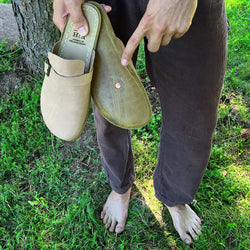
 Shoes
Shoes
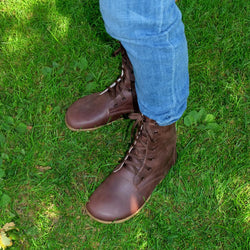 Boots
Boots
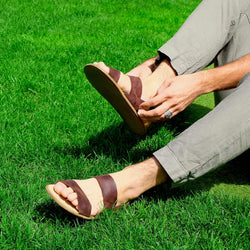 Sandals
Sandals




